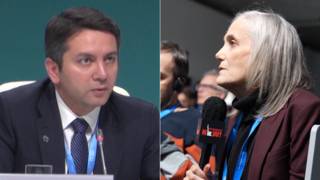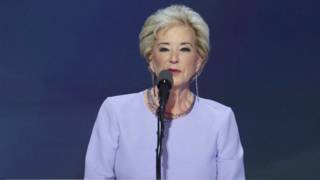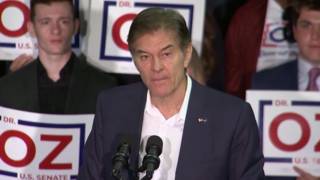
Related
Guests
- Tim Dickinsonpolitical correspondent for Rolling Stone magazine. His most recent article is 'The Spill, the Scandal, and the President'
An extensive new investigation into the Obama administration’s handling of the BP oil spill disaster reveals that it was government mismanagement, delays and absence of oversight that allowed the crisis to spiral out of control. In the article “The Spill, the Scandal, and the President,” Rolling Stone’s Tim Dickinson writes, “Though George W. Bush paved the way for the catastrophe, it was Obama who gave BP the green light to drill.” Dickinson explores how Interior Secretary Ken Salazar kept in place the oil industry-friendly environmental guidelines that Bush had implemented and ultimately let BP, an oil company with the worst safety record, to get away with murder. [includes rush transcript]
Transcript
JUAN GONZALEZ: New government estimates have found the BP oil spill may be spewing twice as much oill into the Gulf of Mexico as previously thought. On Thursday, the Flow Rate Technical Group released its new estimate of 25,000 to 30,000 barrels of oil a day based on information gathered last week, before BP installed a new capture device. Some scientists have warned that the flow rate sharply increased after BP cut the pipe, known as the riser, to install the new device last week. The current estimates from the government panel suggest that an amount equivalent to the Exxon Valdez disaster could be flowing into the Gulf of Mexico every eight to ten days. The new numbers were released shortly after a scientist on the Flow Rate Technical Group publicly warned that the oil may be spewing out at a rate of more than 100,000 barrels a day, a figure BP once called its worst-case scenario.
As public anger over BP continues to grow, President Obama was questioned on NBC’s The Today Show earlier this week about why he had not yet directly spoken to BP CEO Tony Hayward. This was his response when asked what he would do if Hayward was a part of his administration.
PRESIDENT BARACK OBAMA: He wouldn’t be working for me, after any of those statements. First of all, we’re going to have to find out why this thing went in the first place. And the fact of the matter is, is that there’s going to be a thorough review, and I don’t want to prejudge it. But the initial reports indicate that there may be situations in which not only human error was involved, but you also saw some corner cutting in terms of safety, and that BP is a multibillion-dollar corporation. It’s talking about paying $10.5 billion in dividends just for this quarter. We are going to have to make sure that not only do they shut down the cap, we are not only going to have to make sure that any deep well drilling process that’s out there is, in fact, failsafe and oil companies know what they’re doing, but we also have to make sure that every single person who’s been affected by this is properly compensated and made whole.
AMY GOODMAN: Well, President Obama might now have some harsh words for BP, but an extensive new investigation into his administration’s handling of the disaster reveals it was government mismanagement, delays, and absence of oversight that allowed the crisis to spiral out of control. The article is called “The Spill, the Scandal, and the President.” It’s published in the latest Rolling Stone.
Author Tim Dickinson is a political correspondent for Rolling Stone magazine. He writes, quote, “Though George W. Bush paved the way for the catastrophe, it was Obama who gave BP the green light to drill” and explores how Interior Secretary Ken Salazar kept in place the oil industry-friendly environmental guidelines that Bush had implemented and ultimately let BP, an oil company with the worst safety record, to get away with murder. Tim Dickinson joins us now from San Francisco.
Welcome to Democracy Now!, Tim. What surprised you most about your investigation?
TIM DICKINSON: That’s a tough one. There’s a lot of doozies in here. I think — I think just the fact — I had written a fairly credulous piece about Ken Salazar when he came in, was appointed with his white hat and his bolo tie, and declared himself to be the new sheriff in town. And we had talked very specifically about his intent to clean up MMS. In fact, one of the first things that he did upon taking office was go to MMS and bust chops and say, “Listen, this behavior that’s been going on for all these years isn’t going to fly anymore.” And Salazar assured me personally that this was not just about ethics reforms, this was, you know, deep, thorough-going reform.
But it turned out that — I think the thing that was most surprising is that Ken Salazar, in the first year in office, put a record number — a record number of acres up for lease in the Gulf. So, while they were taking, you know, drilling out of view of national parks on land and scaling back the oil shale development, they were throttling up offshore oil drilling to record levels without doing the substantive reform that would have been required to make MMS something other than a candy store for the oil companies.
JUAN GONZALEZ: But, Tim Dickinson, as you also note, it should not have come as a surprise, because Salazar already had a record while in the Senate of backing greater exploration offshore. Can you talk about that?
TIM DICKINSON: Yeah, he had, back in 2006, opened up eight million acres of the Gulf through a bill that he sponsored, and he had pushed President Bush to make oil companies develop their existing leases more quickly. And someone described this to me that there’s sort of an onshore Ken and an offshore Ken Salazar, and he has a very sort of highly specific soft spot for offshore drilling. And don’t — I can’t account for what that’s about exactly, except that, as a Westerner, I think he’s sort of more acutely aware of the damage that development can do to the landscape, and maybe this is a way he’s seen as to create a — you know, create the problem someplace else other than in his beloved Western landscape.
AMY GOODMAN: Tim, start where you start, on May 27th. It’s like a month into the oil spill, and you have —-
TIM DICKINSON: Right.
AMY GOODMAN: —- President Obama striding into the podium of the East Room. Take it from there and then trace back the responsibility.
TIM DICKINSON: Well, so, Obama stood up and said, you know, “We take — the buck stops with me,” essentially, is what he said. He said that the reforms at MMS hadn’t been urgent enough and that he took responsibility for that. You know, and he said that, you know, “My biggest fault was sort of taking the oil companies at their word that they knew what they were doing and had a worst-case scenario plan.” But as it turns out, that’s not just something that Obama should have been taking his word — the word of the oil companies for, but MMS in fact is responsible for reviewing the worst-case scenario cleanup plans of these oil companies.
And in BP’s case — BP talks about protecting walruses in the Gulf in their cleanup plan, and they have a cleanup plan that is supposed to be good for a spill of 250,000 barrels a day. That is to say, an Exxon Valdez every day. They claim the capacity to significantly address the cleanup from a spill of that size. And it’s just ridiculous. It’s laughable. And so, there was no oversight in terms of the cleanup end of this.
And then, you know, in terms of — so Obama and Salazar take over. They go in eyes wide open, and they say, “OK, we know that there’s a problem here.” And this is — I mean, the ownership of this actually starts in sort of an admirable place. Even before Obama took office, he said, you know, “This is my great friend Ken Salazar, and he’s going to come in and make sure that Interior is much more than a service company for the special interests.” And Ken Salazar puts on the white hat and says, “There’s a new sheriff in town,” and goes about sort of trying to clean up an agency that had descended into rank criminality and, you know, oil — MMS staff partying with oil staff, oil company officials, and doing drugs with them. The corruption of this agency is really sort of hard to overstate.
But what Ken Salazar did, he has a chief of staff who’s a former attorney general with Colorado, and they sort of cleaned up the rank criminality bit, but the reform didn’t go any farther than that. So they left in place top managers who had risen through the ranks in this incredibly pro-development oil culture, such that on the day that Ken Salazar announced his reforms of MMS, in the Alaska office they served a cake that says “Drill, baby, drill” on it. And so, this is — the rot at MMS extends far beyond what was a criminal problem, and it goes to managers who only get promoted if they sort of suppress science and fast-track drilling. And so, that’s the culture of this place, and, you know, which is a longstanding problem, but they had promised to clean it up. And then, but instead of doing that, they — again, like I said, they started to just throttle up offshore drilling to unprecedented levels.
And, you know, to his credit, when Salazar came into office, he also threw out Bush’s plan to open up essentially every coastline in America to offshore drilling. And this was just sort of a last-minute wet dream for the oil companies, that was not a serious proposal, and no one expected that to stand. The Bushes put it in the federal register either at midnight or after midnight on the day that they left. So this was not anything more than a gesture on their part. And so, Salazar, to his credit, took that off the table, but a year later came back with his own plan, which essentially split the baby and seemed to split the baby along political lines, so that red states were exposed to new drilling and blue states, including the Pacific coast, were not, and the Atlantic coast north of New Jersey.
And so, he and President Obama appear at an Air Force base in front of an F-18 fighter jet and a giant American flag in this sort of stage craft that had all the trappings of the “mission accomplished” photo-op. And they said, “You know, we’ve looked at this for a year. This is a hard decision. We’ve looked at it for a year. We’re ready to roll here.” And Salazar said, you know, “Our forms are working. We have an agency that’s capable of handling this.” And, you know, then a couple days later, President Obama, unbidden, says, you know, oil rigs are safe. And so they took ownership of this completely, right before the disaster, without having implemented any of the substantive reforms that they should have, and so that what that did is it left in place a drilling program that not only — it’s a complicated issue, but the Bush environmental reviews were structured so that you would have a detailed environmental assessment of the region, an environmental assessment of the individual leasing blocks, and then for each drilling project they would get a categorical waiver, just a get-out-of-environmental-review-free card. And so, the BP drilling site had gone — was sort of — and so, each drilling permit was based on these three levels, and so he said, “Well, we did the review at the top, and then we did the secondary review. And the tertiary review, we don’t have to do, because we did the other two reviews.” But the other two reviews were crap. They were — didn’t account for the possibility. They called a blowout a low-probability, low-risk event, which is — you know, I could understand the low-probability part, but the low-risk is just absurd.
AMY GOODMAN: Tim Dickinson, we have to break.
TIM DICKINSON: And so, when —-
AMY GOODMAN: We have to break, but we’re going to come -—
TIM DICKINSON: OK, but they — so the Bush — the short story is that they took those —- they took Bush’s word on the science and then issued the get-out-of-environmental-review card free to BP.
AMY GOODMAN: Under Obama. Tim Dickinson, we’ll be back in a minute -—
TIM DICKINSON: Yeah.
AMY GOODMAN: — political correspondent for Rolling Stone. His piece is “The Spill, the Scandal, and the President.” Back in a minute.
[break]
AMY GOODMAN: “Waving Flag” performed by Somali Canadian rapper K’naan in our former firehouse studios. K’naan is performing today in Johannesburg at the World Cup opening ceremony that’s being hosted by South Africa. His song “Waving Flag” was chosen as the official anthem of the competition. But there is a catch. Coca-Cola, the official sponsor of the World Cup, asked K’naan to rewrite part of the lyrics that called Somalia of violent-prone poor people zone, referring to its people as “struggling, fighting to eat.” K’naan defended his decision to rewrite the lyrics. He said, quote, “I don’t work for Coke or anything; what I do is my music. This was a really great opportunity for them to use my song, without compromising my integrity as a musician.” We’ll have more on the World Cup later in the broadcast.
This is Democracy Now!, democracynow.org, the War and Peace Report. I’m Amy Goodman, with Juan Gonzalez, as we stay on the issue of the oil spill in the Gulf of Mexico, the geyser that continues to gush what some are estimating something like more than four million gallons a day. Just as we go back to Tim Dickinson, Rolling Stone reporter who did this very interesting piece called “The Spill, the Scandal, and the President,” Juan, you, in your column today in the New York Daily News, wrote a very interesting piece about spills in the Gulf of Mexico.
JUAN GONZALEZ: Yes, and I would like to also to summarize it, then throw to Tim in terms of the issue that you deal with of safety. I reported in the Daily News today based on an analysis that’s been done by Walter Hang of Toxics Targeting, a firm in Upstate New York that traces spills across the country, hazardous spills, that there had been literally thousands of spill reports in government databases over the past several decades in the Gulf of Mexico and that they have been increasing dramatically, especially the significant spills, since the Bush administration came in. I think there were about 330 significant oil spills in the Gulf since 1964, and half of them have occurred in the last ten years, the Bush administration and the beginning of the Obama administration, and that BP has been the firm with the most spill reports, twenty-three in the last ten years.
These have included things like oil platforms and rigs that were destroyed by hurricanes, wells that lost control, deep sea risers that became detached or severed, boats that collided into platforms and sank. There was even one report — this was the most astonishing one — given to the MMS, that a rig, after Hurricane Ike — one company reported that its oil rig became detached in November of '08 after Hurricane Ike, was lost at sea for five months. It was found in March of 2009 when a ship collided with the rig that was barely underwater. And that's when they discovered the rig, five months later. But that the number of incidents clearly should have signaled to the government that they were increasing, the number of accidents, and that a big one was bound happen.
You’ve reported about BP’s accident problems in other parts of the world, as well, and its safety record. Could you talk about that?
TIM DICKINSON: Right, and first, to your point about the increasing number of accidents, the NOAA, in fact, in their review of the Obama “Bush Lite” plan to open up offshore drilling, made note of the fact that the Obama administration was using pre-Hurricane Katrina and Rita data, so that they were, you know, significantly understating the number of spills in assessing the risk and that they were also underplaying the global risk of an oil spill.
But to your point about BP, I mean, BP, it just has to be noted as a serial felon. I mean, they had a felony conviction in, I think, '99 about the essentially dumping of oil or oil byproduct in Alaska into the open environment, and then another felony conviction following the 2005 disaster, in which an oil refinery, where they had cut costs and scaled back required safety equipment, blew up and killed fifteen people and injured 170 more. And so, you know, BP was also the lead — was in charge of the consortium that was supposed to respond to the Exxon Valdez in 1990, and that response was hampered in the early hours because they didn't have the right equipment available. And Exxon fairly quickly realized that BP was not a good partner and shoved them aside. And then BP was also responsible for the — what was the second-largest leak after Exxon Valdez, just recently up in Prudhoe Bay, where there was a pipeline that was corroded because they hadn’t done required maintenance, again in a cost-cutting move. And so, BP has this incredibly criminal history of cutting corners, you know, for the sake of adding to the bottom line, and it has repeatedly risked worker safety and worker lives, and in fact, you know, ended up in people dying, again now, repeatedly, and also just massive, massive harm to the nation’s environment and our public welfare. And the fact that this serial felon is still, you know, essentially in charge of trying to cap this leak is astounding to me. I don’t understand — I just don’t understand it.
AMY GOODMAN: Tim Dickinson, you point out that this particular well in the Gulf that exploded is one of the richest in the Gulf of Mexico. Talk more about that.
TIM DICKINSON: Well, so I was talking to someone who’s privy to discussions at some of the — one of the largest oil firms in the world, and he was just sort of saying, well, how many wells in the Gulf are as productive as this spill, this output of this current well appears to be? And it’s just a handful. And so, it seems clear that BP, you know, struck it rich here, except that they totally botched it. And now we’ve got a dirty bomb that’s going off every day in the Gulf, and we don’t really have any sure-fire hope of getting it sealed up until August, September, October. No one seems to be able to answer exactly what the probability of getting these relief wells drilled and sealed off appropriately, as it seems likely that it’s going to happen eventually, but no one seems to have a very high level of confidence it’s going to happen on the first try or the second try or the fourth try. I think when they tried to do this in the East Timor Sea, it took ten tries, and that was in shallow water. So this is a problem that’s not going away anytime soon.
AMY GOODMAN: Tim Dickinson, we want to thank you very much for being with us, political correspondent for Rolling Stone magazine and author of rollingstone.com’s political blog called “National Affairs.”
During our trip to the Gulf region — during our trip to the Gulf region, we went to Grand Isle, and we looked at all of the different issues, talked to many different fishermen who had been told that they’ve been — well, let me just say, we wanted to play a clip for a minute of a fisherman named Glenn Swift. We played this before, but, Juan, I didn’t get to talk with you about it. It’s very interesting. This fisherman in Louisiana, who was told that if he signed a contract with BP, he would be able to get paid. He just couldn’t talk to the press, if he did. This is Glenn.
AMY GOODMAN: In the contract that they sign to get paid, that the fishermen sign to get paid, they are not allowed to speak?
GLENN SWIFT: Right. It says that it’s grounds for termination of employment.
AMY GOODMAN: Have you seen that on the paper?
GLENN SWIFT: Yes, mm-hmm.
AMY GOODMAN: Who showed it to you?
GLENN SWIFT: They actually gave us a contract that we signed. I’m not sure, but maybe that contract’s been done a lawyer, but I don’t know.
AMY GOODMAN: Did you sign it?
GLENN SWIFT: Yes.
AMY GOODMAN: So why are you talking to me?
GLENN SWIFT: I don’t feel it’s the right thing to shut somebody up, you know, just because you’re working for them. We’re supposed to live in the United States, and we’re supposed to have freedom of speech.
AMY GOODMAN: That was Glenn Swift, Glenn Swift who now says that after they sign these contracts, that we have copies of, he received an amended copy of the BP contract that removes the provision barring cleanup workers from speaking to the media. BP didn’t amend the contract until more than a month after the Deepwater Horizon rig explosion. But clearly the tone had been set. When we met with Dean Blanchard, the seafood entrepreneur, one of the biggest seafood industries he runs in Grand Isle, we went up to fishermen who had contracts with BP, and they were terrified to talk to us, though clearly they were incredibly frustrated with BP.
And another issue is, when it came to the safety of the workers, they — many of them said that they were told that they could not wear masks. And you know your work from 9/11. They actually couldn’t wear masks because it would look like the situation was dangerous, and they desperately need money from BP, but they — so they weren’t going to risk losing their jobs.
JUAN GONZALEZ: And, of course, now all of these — all of the — or many of the people working out there are getting sick as a result of the lack of safety provisions. Well, it goes to show you. I mean, BP now has Dick Cheney’s former spokesperson as their director of communications. So I think that they’ve learned from the previous administration how to botch public relations.
AMY GOODMAN: And when BP’s Tony Hayward was asked about the chemical contamination of fishermen in the hospital, he said he didn’t doubt that people were sick, but maybe it was because of food poisoning.
JUAN GONZALEZ: Yes.
AMY GOODMAN: To which Dean Blanchard responded, the seafood distributor in Grand Isle whose business is just, to say the least, going down the drain, said, “Then why are they taking, confiscating, the clothes of the fishermen as they go into the hospital? They’re not testing for food poisoning; they’re testing for chemical contamination.”
Let’s move from worker safety from the spill to West Virginia.












Media Options